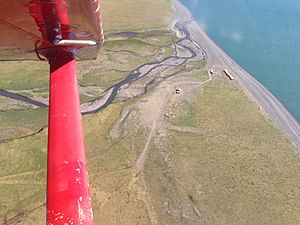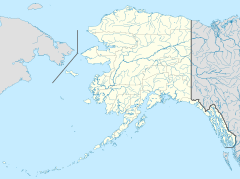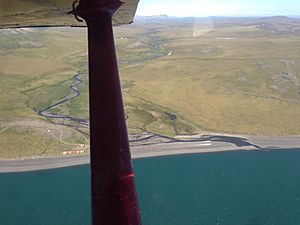Chariot, Alaska facts for kids
Quick facts for kids
Chariot
|
|
|---|---|
|
Research site
|
|

Aerial shot of Chariot, AK located near Cape Thompson. The once-proposed site of an artificial harbor created using chained nuclear explosions.
|
|
| Country | United States |
| State | Alaska |
| Borough | North Slope |
| Time zone | UTC-9 (Alaska (AKST)) |
| • Summer (DST) | UTC-8 (AKDT) |
| GNIS feature ID | 1400155 |
Chariot is a special research site located on the coast of Alaska. It sits by the Chukchi Sea in the western part of the North Slope Borough. This area is very close to a small stream called Ogotoruk Creek. It is also about 10 kilometers (6 miles) southeast of Cape Thompson. The highest point at Chariot is about 20 meters (65 feet) above sea level.
Contents
What Was Project Chariot?
Chariot was named around 1962. This happened during a time when a big science idea called Project Chariot was being discussed. The name "Chariot" might have come from a main building at the site.
A Bold Idea for a Harbor
Project Chariot was a plan by the United States government. Scientists wanted to use nuclear explosions for peaceful purposes. Their idea was to create a deep-water harbor near Chariot. This harbor would be made by setting off several nuclear devices underground. The explosions would dig out a large basin.
Why Was This Project Proposed?
The main goal was to create a new port in the Arctic. This port would help ships travel and transport goods. It was part of a larger program called "Operation Plowshare." This program explored using nuclear explosions for big construction projects. These included digging canals or creating mines.
Concerns and Why It Didn't Happen
Even though the idea was bold, many people had serious concerns. Scientists and local communities worried about the environment. They were concerned about radioactivity and its effects on wildlife. They also worried about the health of people living nearby.
- Environmental Impact: Experts feared the explosions would harm the delicate Arctic ecosystem. This included animals like seals, whales, and caribou.
- Radioactive Fallout: There were worries about radioactive dust spreading. This could contaminate the land, water, and food sources.
- Local Opposition: The native Alaskan people living in the area strongly opposed the project. They relied on the land and sea for their way of life. They feared the project would destroy their hunting and fishing grounds.
Because of these strong concerns, Project Chariot was eventually canceled. No nuclear explosions ever took place at Chariot. Today, the site remains a reminder of a time when scientists explored unusual ways to use nuclear energy. It also shows how important it is to listen to environmental and community concerns.



